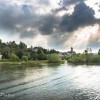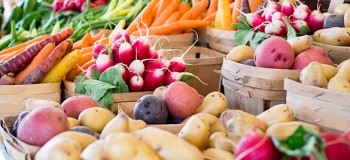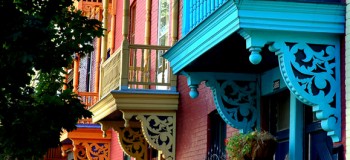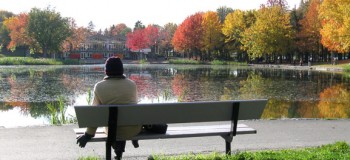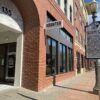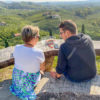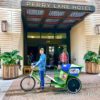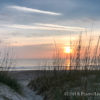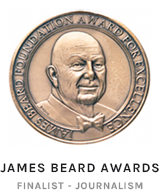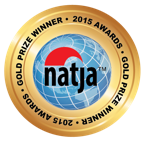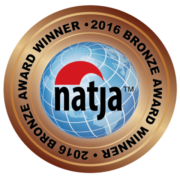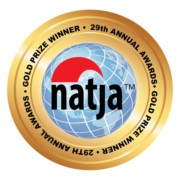A Visit to Conegliano Valdobbiadene Prosecco Superiore DOCG – The Prosecco Superiore Region of Italy
The Wineries Along The Prosecco Road
As we traveled each day along the Strada del Prosecco or Prosecco Road, I was fascinated by the beauty of the terraced vineyards and hill towns decorated with ancient abbeys, churches, and farmhouses. This 20-mile long and narrow, winding route was the first wine route established in Italy in 1966.
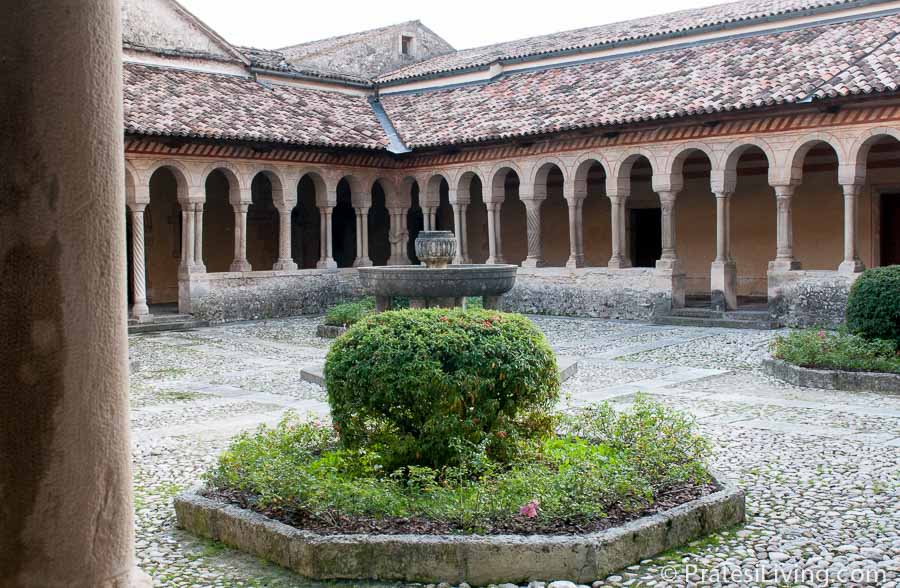
Follina Abbey
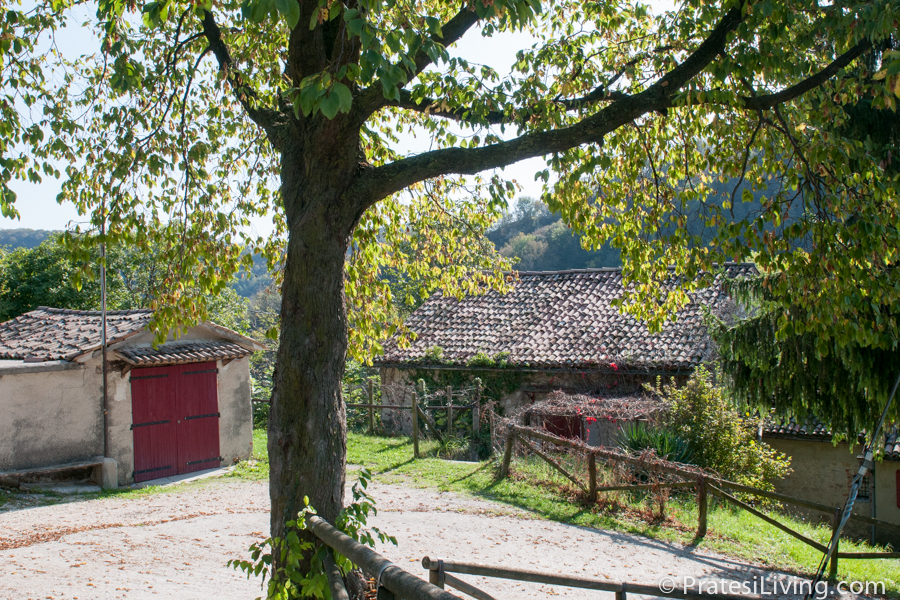
The scenic pathways in Combai
It was late October, and the warmer than usual fall weather brought gorgeous sunny days and preserved much of the landscape’s lush greens of summer. There were also vineyards painted in autumn’s golden hues, rather than the brilliant orange and red fall-colored palette I had anticipated. On several of our drives, mainly on quiet wooded backroads, we found residents from the villages with baskets in hand while foraging for mushrooms.
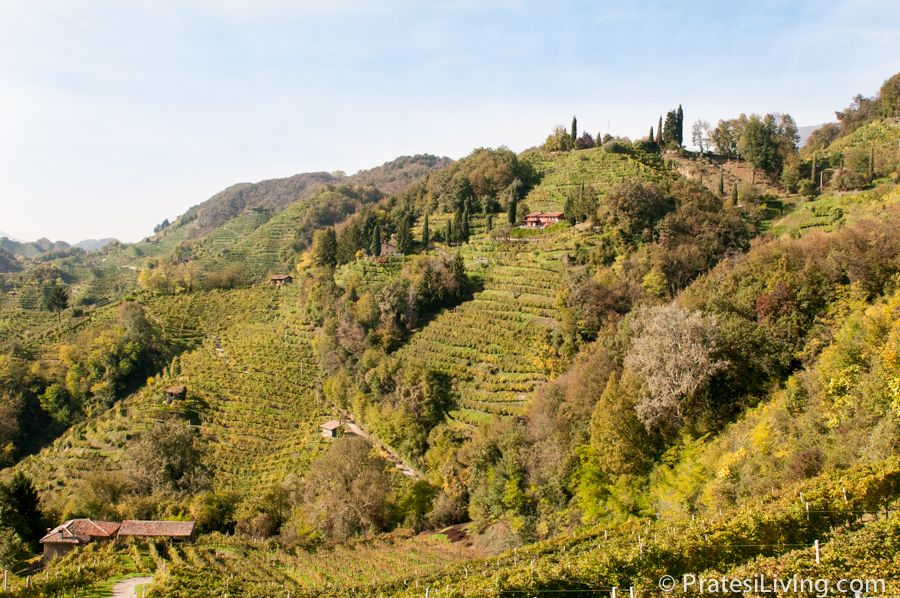
Autumn’s golden palette along the Prosecco Road
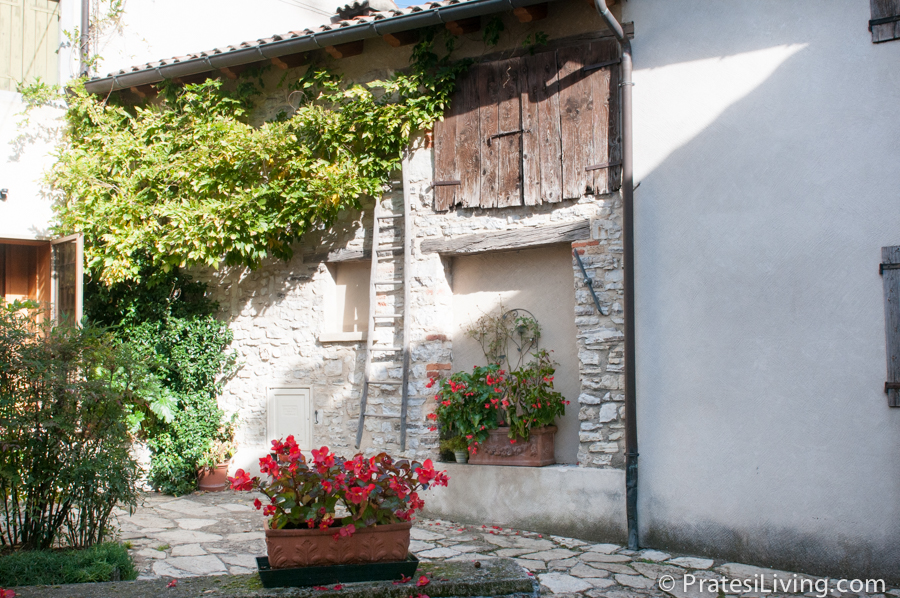
A farmhouse in Combai
Every day we visited wineries and would tour the steep hilly vineyards by Land Rover, often stopping to gaze out over the valleys and take in the views. I also saw what’s known as “heroic vineyards,” which are the most precipitous hillsides that produce the Rive wines, a collection of “crus.” You can understand just how difficult harvesting these grapes is when you see the grade of these steep slopes, especially combined with the rugged and rocky terrain.
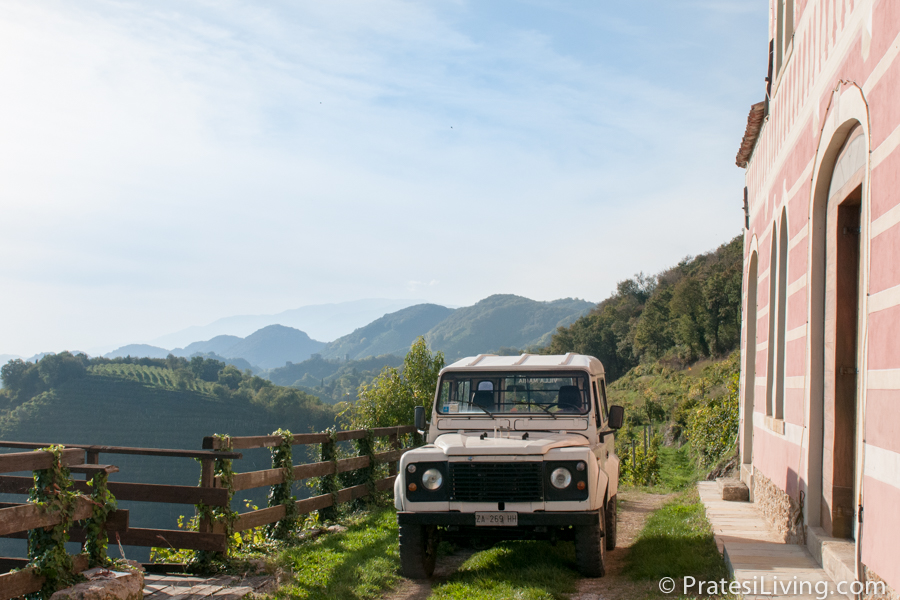
Touring the steep vineyards by Land Rover at Villa Maria
The September harvest for Prosecco Superiore is all done by hand, just as it was done hundreds of years ago. The workers pick the bunches of grapes and transfer them to buckets or containers which are sent down the hills by an overhead carrucole (pulley system) or tracks on the ground called monorotaie (monorail). It is estimated that the average time it takes to work these hillside vineyards is 600 hours per hectare each year compared to the 150 hours it takes in the valleys or plains.
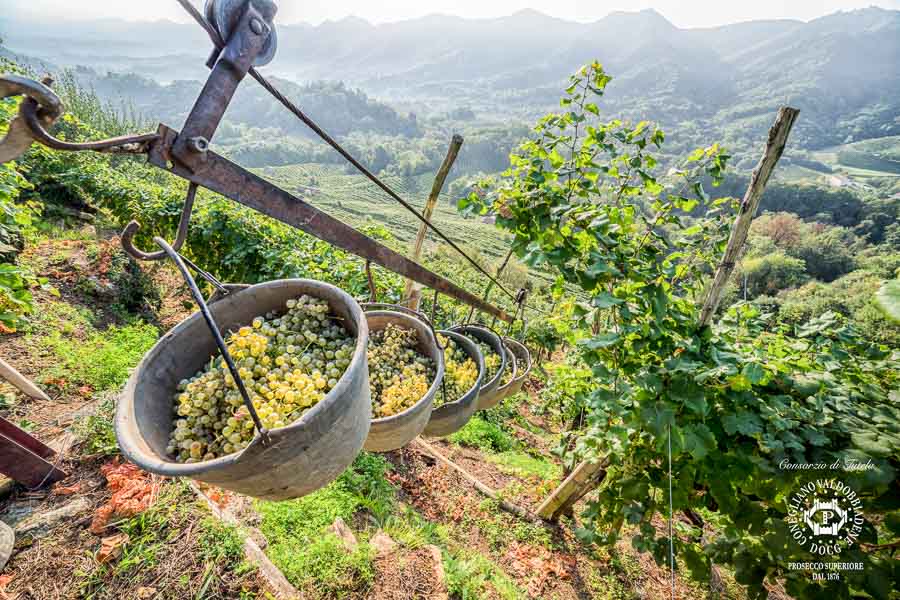
* The overhead pulley system or carrucole (Photo credit – Arcangelo Piai)
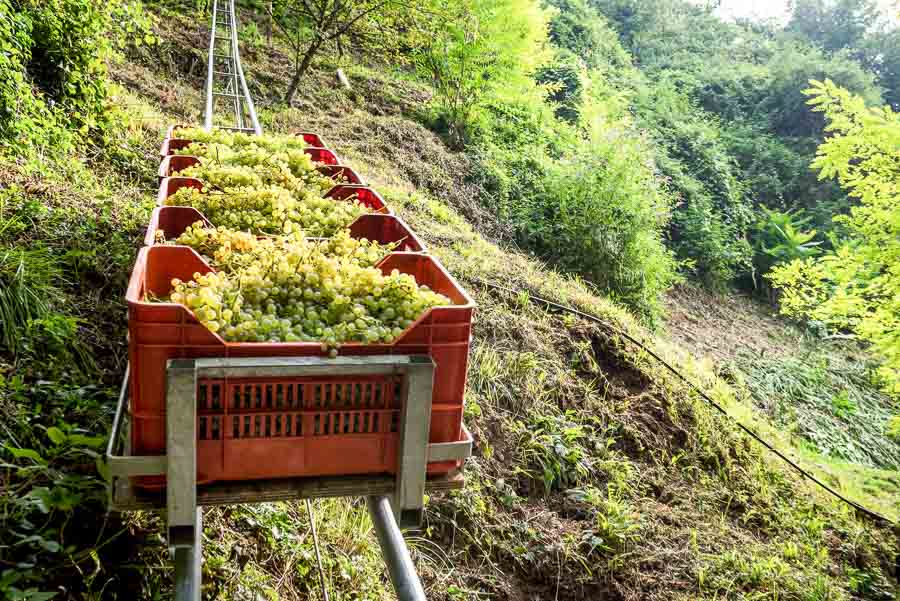
* The monorail or monorotaie (Photo credit – Arcangelo Piai)
There are over 3,400 families growing grapes in the region, with 185 producers making sparkling wine. Most of the wineries are family-owned and vary in size and in the amount of wine they produce.
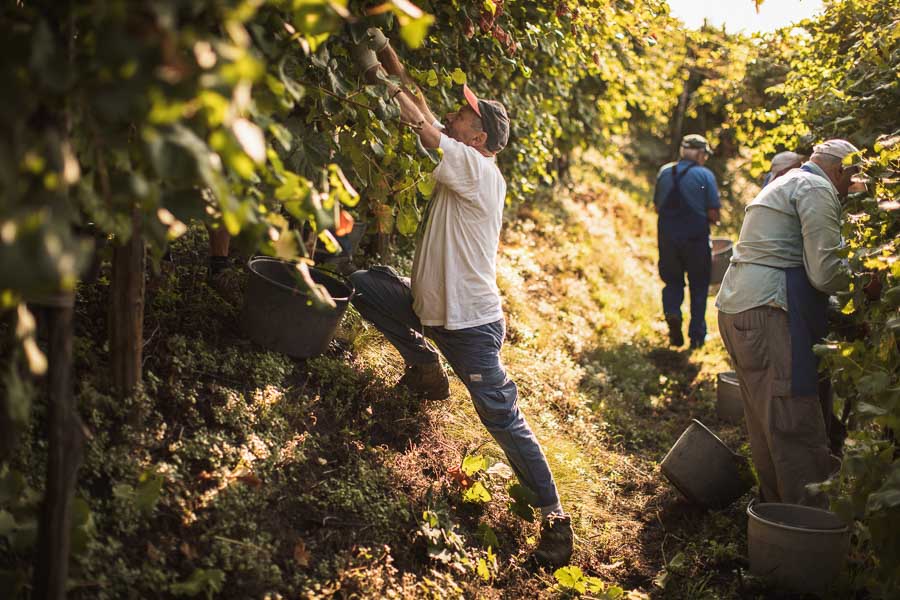
* Harvesting the grapes (Photo credit – Beatrice Pilotto)
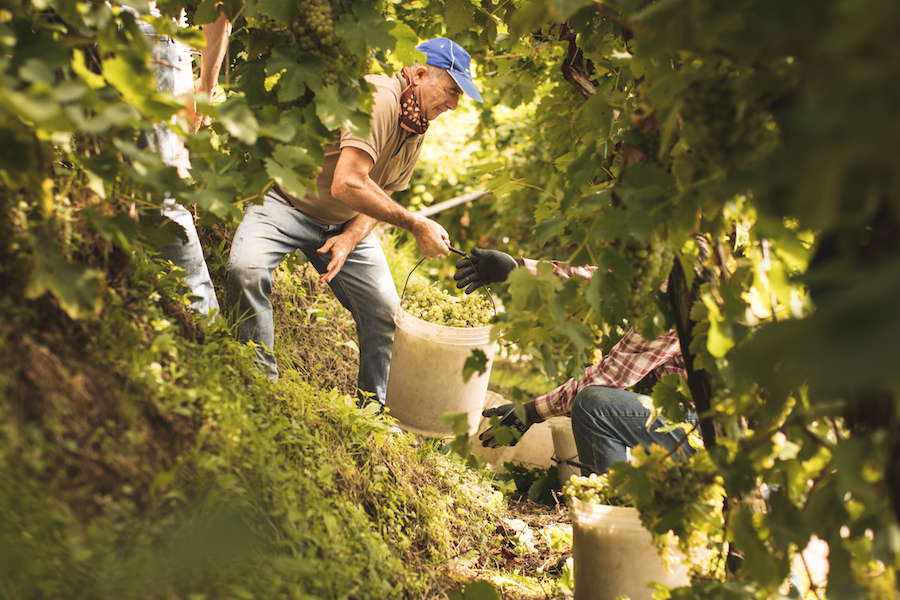
* Heroic Harvest on the steep hillsides (Photo credit – Beatrice Pilotto)
One of the wineries I visited was Col Del Lupo, a small family winery, where I toured the vineyards with brother and sister, Marco and Giulia, and then sampled their Prosecco Superiore with small bites that their mother Diana prepared for us to pair with the wines.
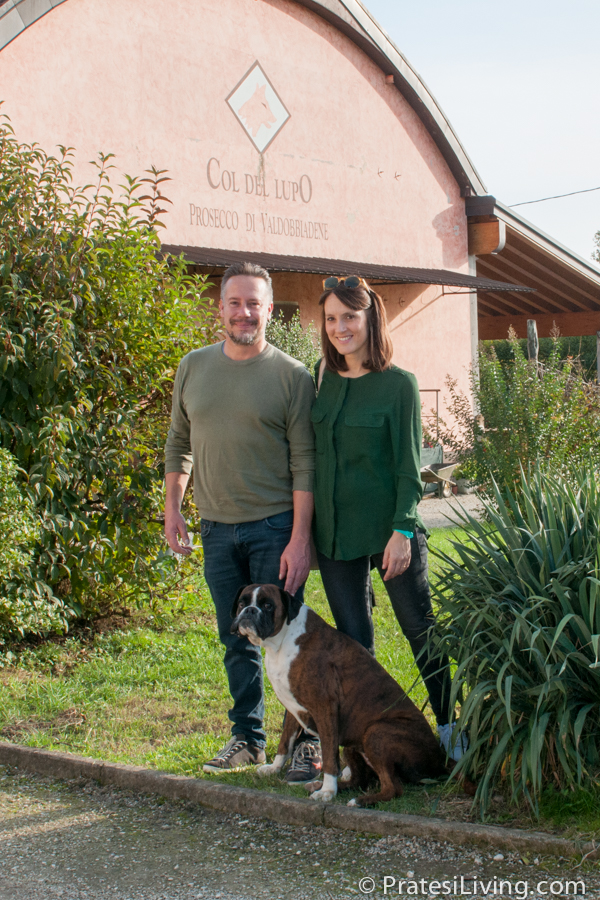
Marco, Giulia, and Maya at Col Del Lupo
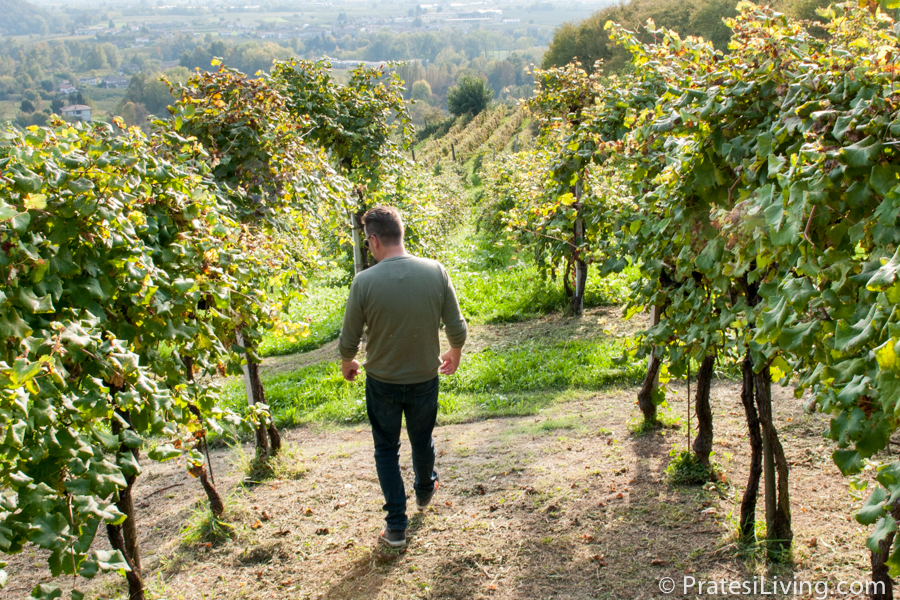
Marco walking the vineyards
I met with winemaker Cinzia Canzian at Le Vigne di Alice, who graciously spent an afternoon showing me around her winery and introducing me to her lovely sparkling wines and Nina, their version of Italy’s signature bitter liquer and digestif, amaro. She also shared with me the story behind the phrase that represents her outlook and philosophy – Life is a Bubble. I couldn’t resist bringing that thought home with me engraved on a wine bag with a bottle of their bubbles inside.
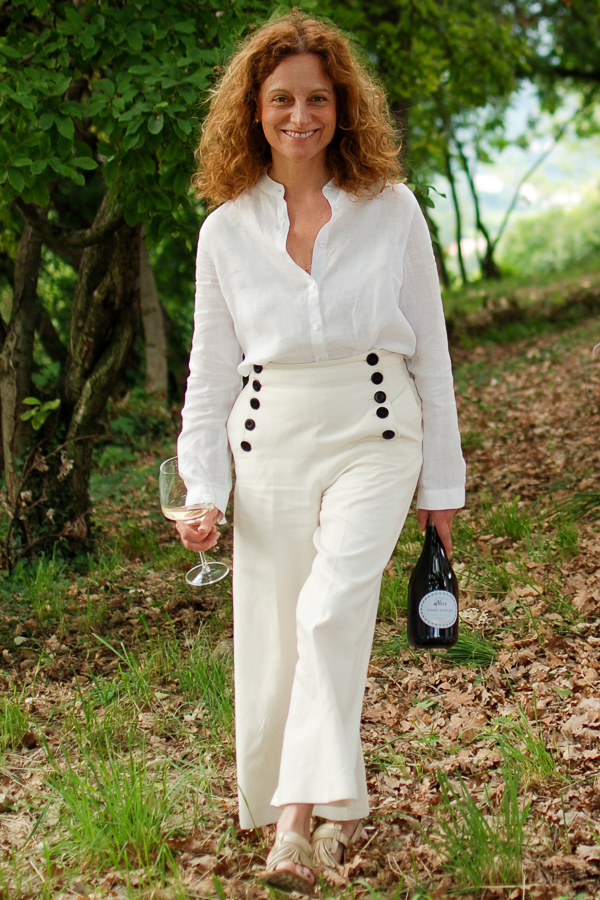
Cinzia Canzian (photo credit – Lucrezia C. Cosmo)
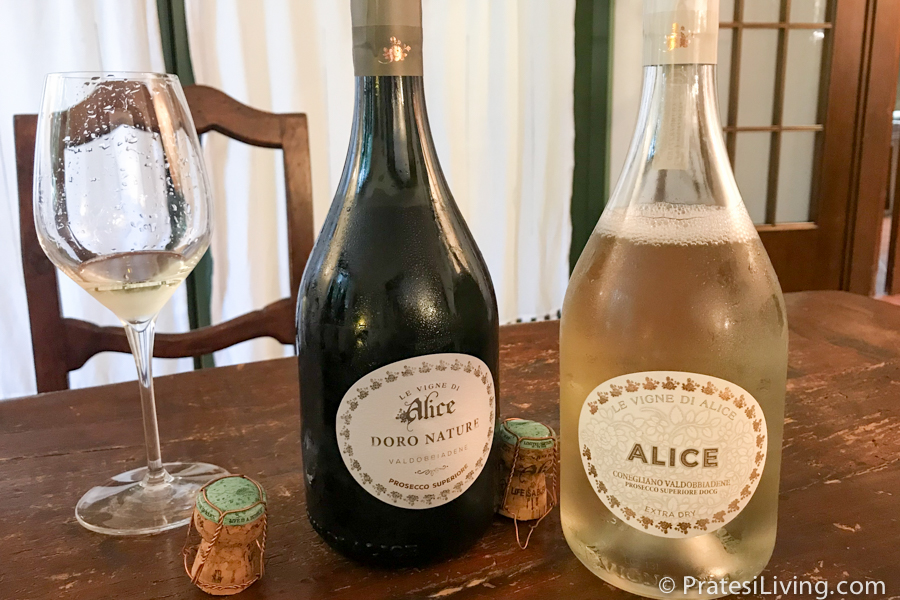
Two of the wines we tasted at Le Vigne di Alice
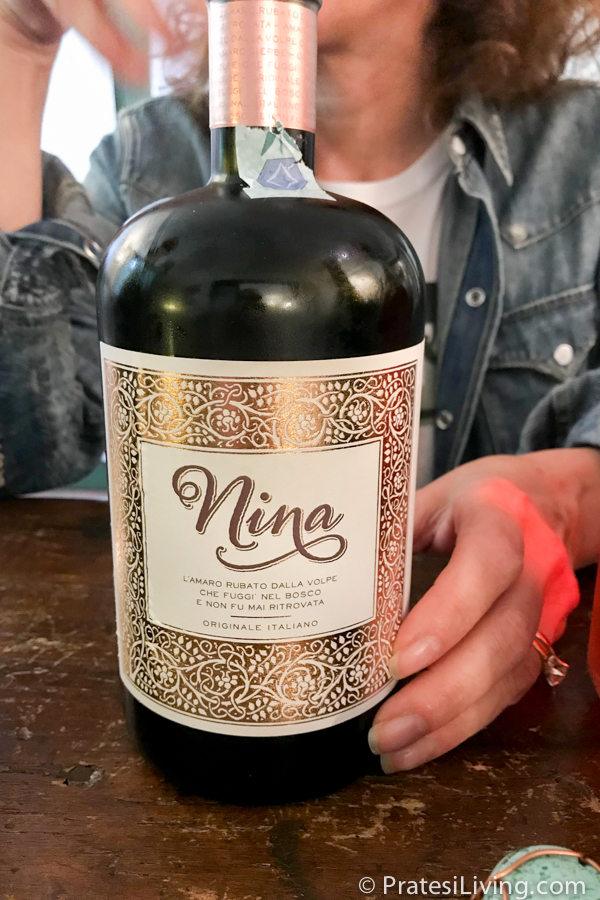
Italy’s amaro – a bitter liquer made from various herbs, roots, fruits, vegetables or pods
We also visited wineries, like Villa Maria, where the Panagai family has been making wine for over 200 years. Roberta, my tour guide, had to translate what was spoken in Italian as winemaker Falcomario di Panigai (as well as several of the other winemakers we met) did not speak English. Of course, the Land Rover excursion into the rugged hills with breathtaking views looking out over Villa Maria’s vineyards spoke for itself and did not need any translation.
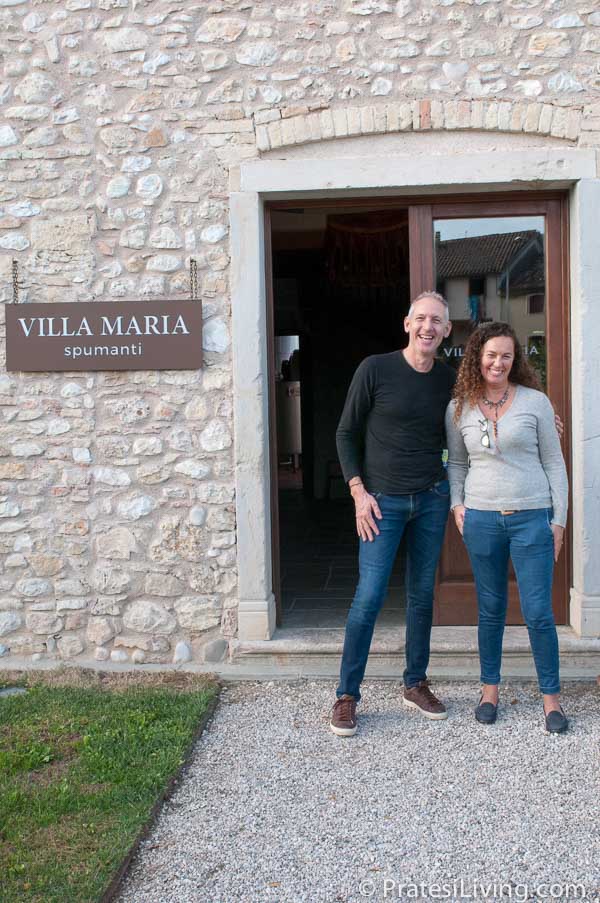
Winemaker Falcomario di Panigai of Villa Maria with Roberta
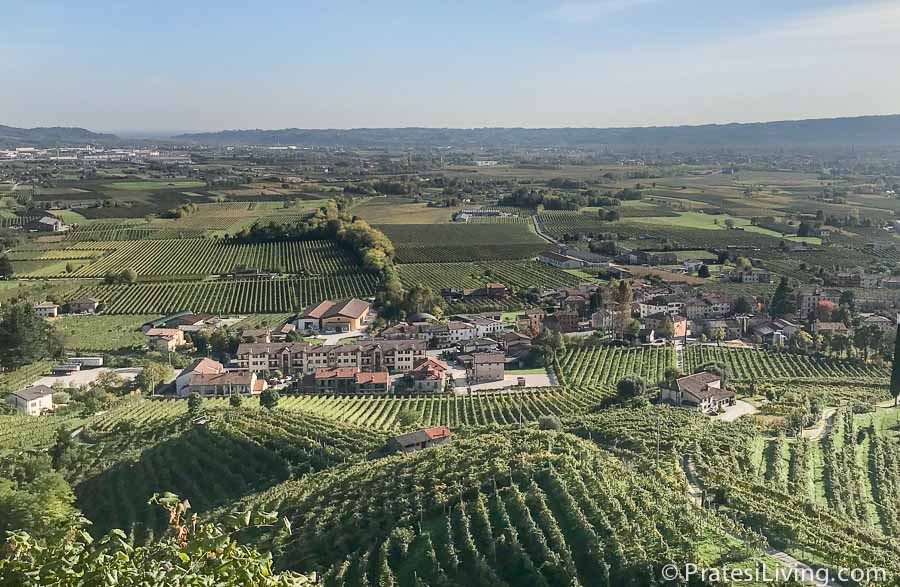
Views from the Hunting Lodge above the terraced vineyards of Villa Maria
Nor did the time spent with Cesare De Stefani, the owner of Osteria Senz’oste, a popular venue for al fresco dining and enjoying a bottle of Prosecco Superiore with a view. As we laughed while sipping his more rustic version of sparkling wine and tasting several types of his charcuterie, he suddenly whisked me away to the back of the building where he proudly showed us the facility where his charcuterie was prepared and aged.
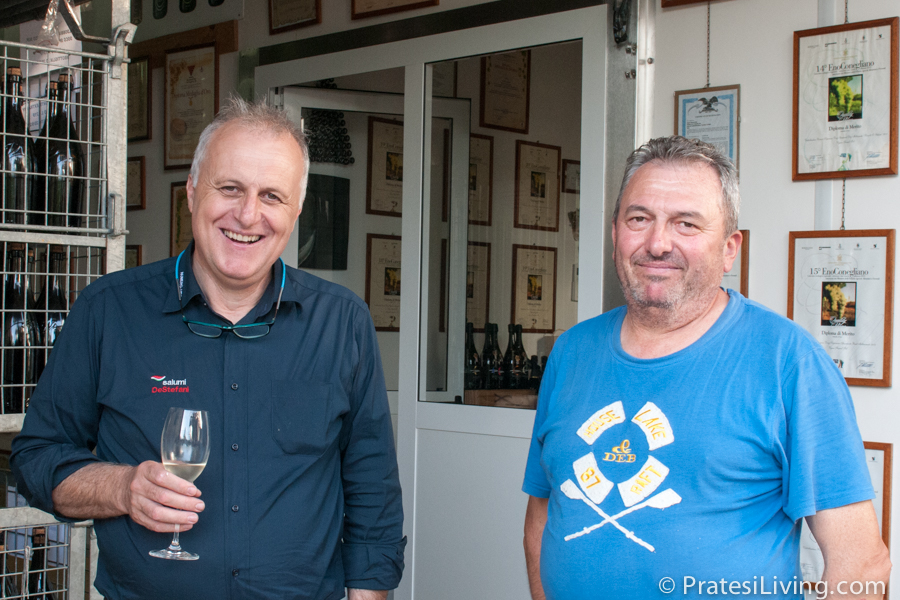
Cesare De Stefani – Osteria Senz’oste
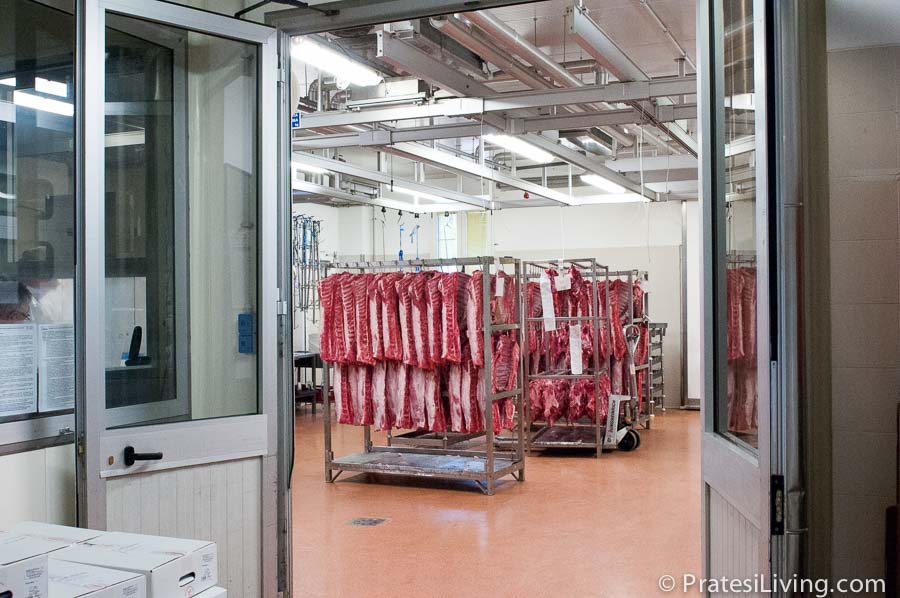
Ready to make charcuterie
The largest of the wineries we visited was Villa Sandi, with its Palladian-style villa dating back to 1622 and an impressive tasting and visitor’s facility. The Moretti Polegato family has owned the winery and this property for generations.
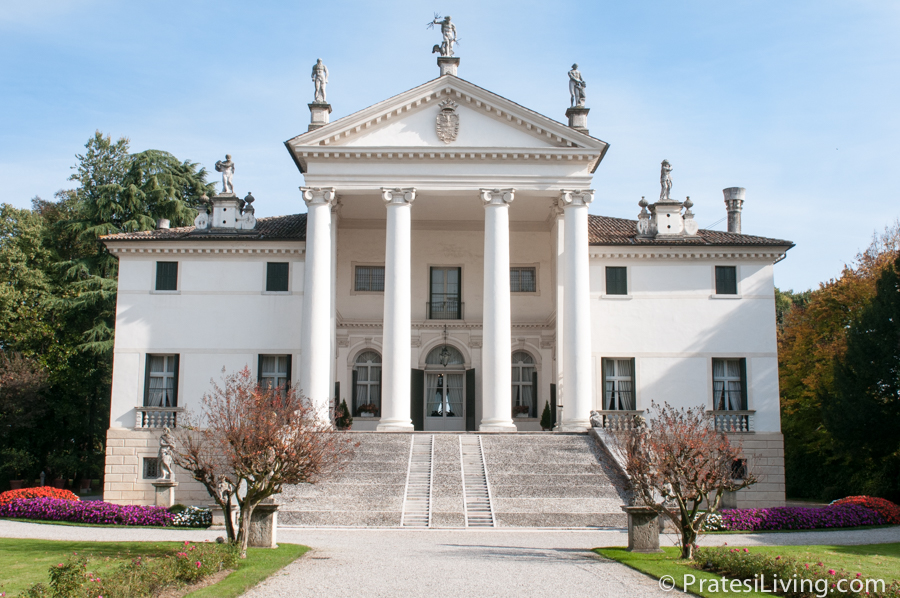
The historic Palladian-style villa at Villa Sandi
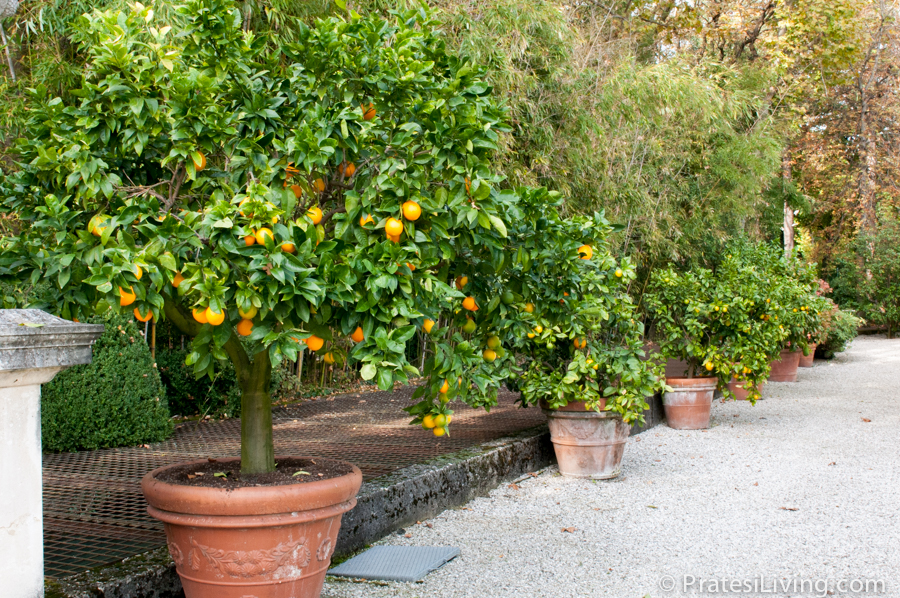
Citrus trees along the walkway
Before dining at Locanda Sandi restaurant, I was afforded an extraordinary opportunity to visit the revered vineyards of Cartizze, a small subzone in the steepest hills of Santo Stefano and Sacco in Valdobbiadene. This pentagonal-shaped plot of land is approximately 107 hectares, with just a hundred growers producing a little over a million bottles a year. Cartizze is also regarded as the most expensive vineyard property in Italy.
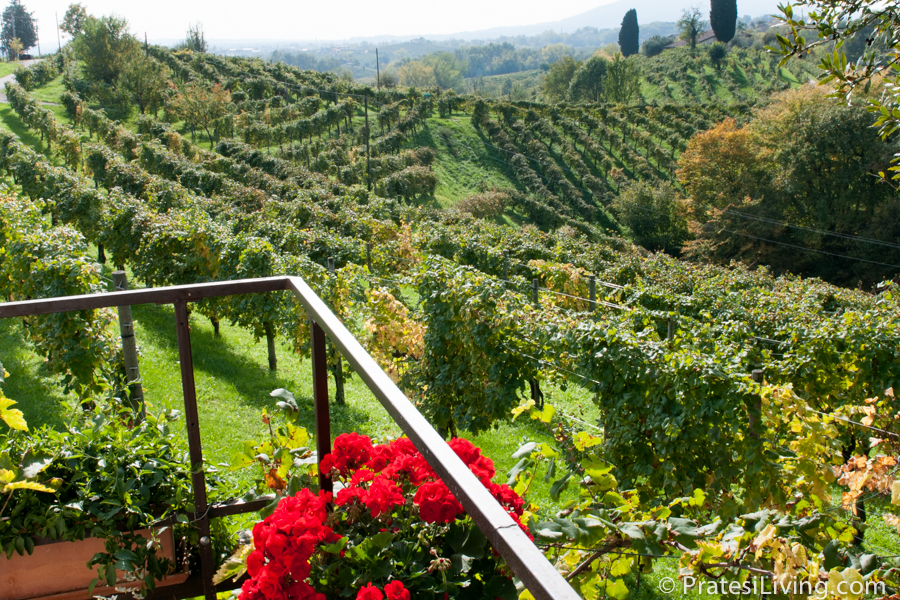
The vineyards of Cartizze
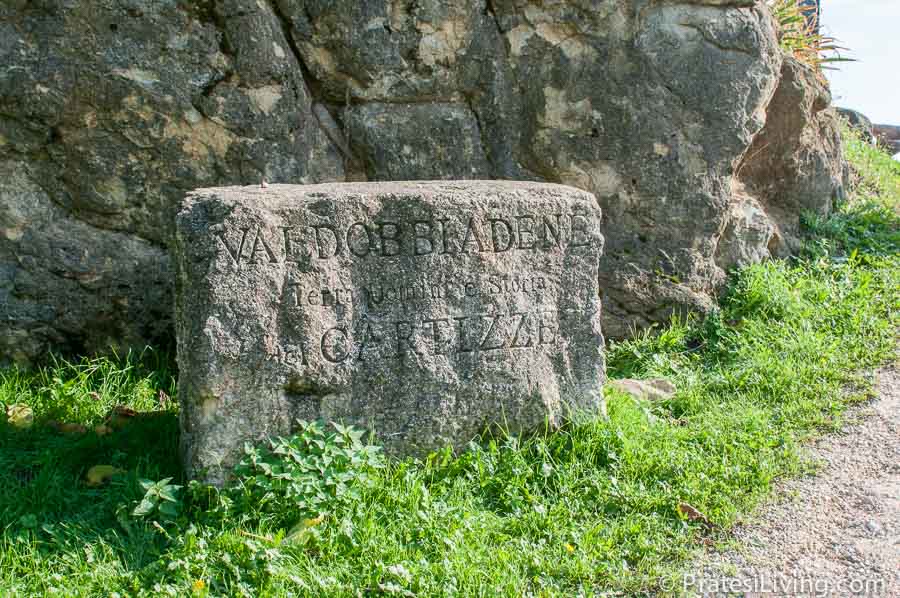
The hills of Cartizze are located in Valdobbiadene
Overlooking the steep vineyards of Cartizze, I sampled a glass of Superiore di Cartizze DOCG, the “Grand Cru” of Conegliano Valdobbiadene. The wine was floral and elegant, with hints of fruit and a bit of sweetness. This unique wine’s characteristics originate primarily from the calcarenite (mostly made up of sandstone) and marl soils (lime-rich mudstone with clay and silt), warm breezes from the Adriatic Sea, and the cool evening winds from the Dolomites. Another contributing factor is the south-facing slopes of the vineyards that allow for more sunlight and create riper fruit than other areas in the region.
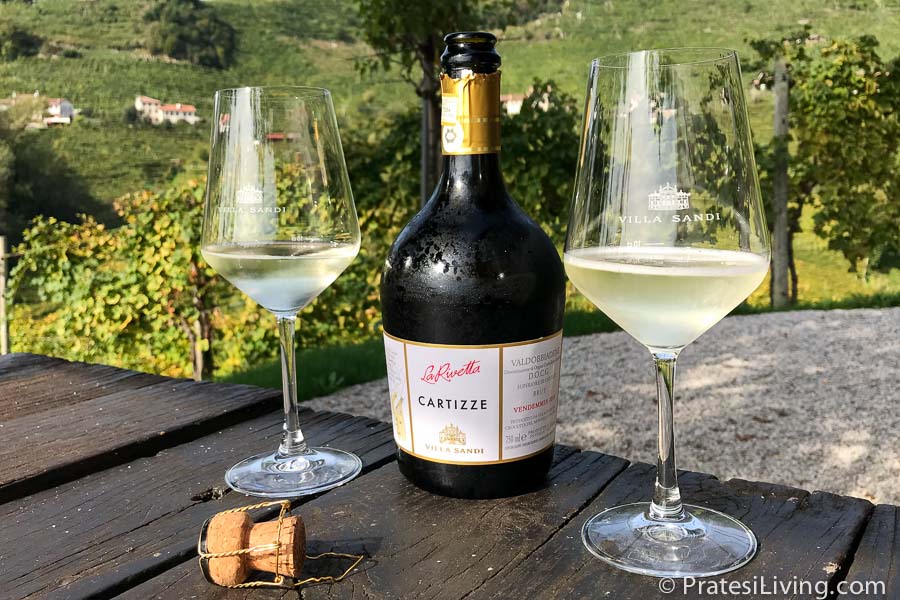
Superiore di Cartizze DOCG
But perhaps the experience that stayed with me the most was my time spent with Riccardo Poletti of Bortolin Angelo. Riccardo asked if I was up for an adventure (why, of course!) as we drove along the rocky and grassy pathways deep into their vineyards. Much to my surprise, he had several bottles of their wine along with local cheeses (made at a dairy in the hills I could see in the distance and would visit later – Perenzin Latteria) and charcuterie (made by Cesare) for a light picnic lunch. He said there was no better way to taste their wines than in their vineyards in Valdobbiadene (and I would agree).
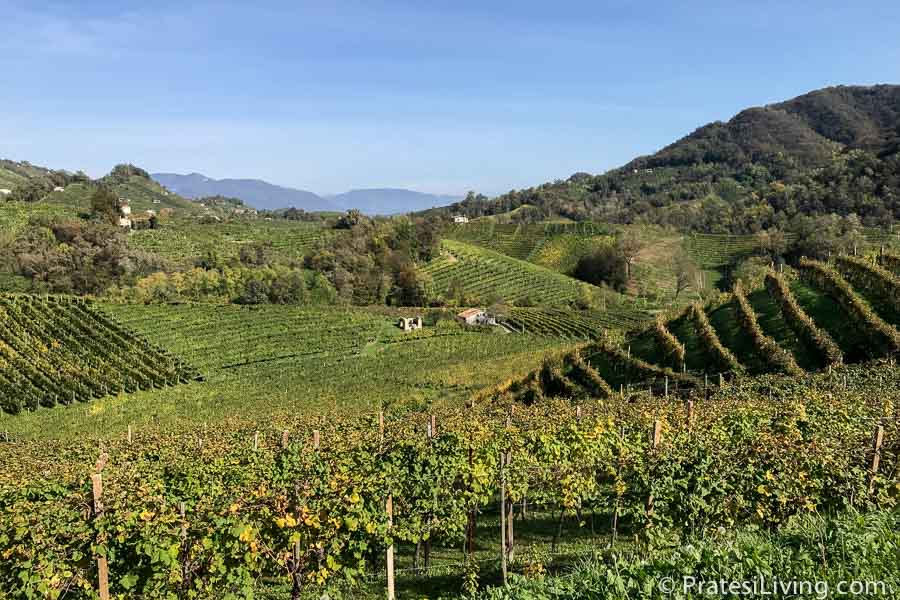
Bortolin Angelo’s vineyards in Valdobbiadene
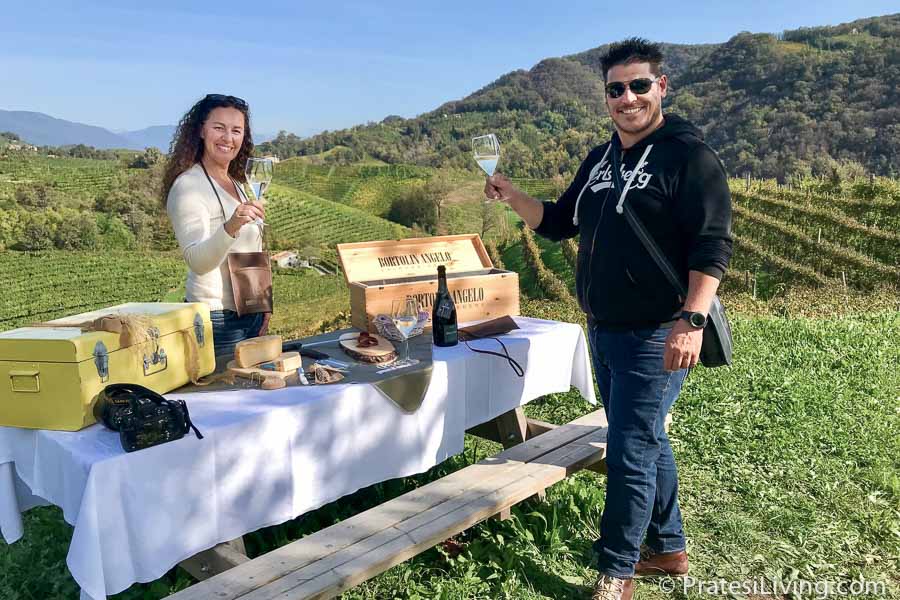
To new friends – Roberta and Riccardo – Saluti!
Riccardo went on to explain what he mentioned to me earlier at the winery – that I should not use the word “Prosecco” when referring to the wine from the hills of Conegliano Valdobbiadene. And it all made sense after my visit and comparing what I was drinking in Italy to the Prosecco I used to drink at home. I say used to because once you’ve experienced Conegliano Valdobbiadene Prosecco Superiore DOCG, you will appreciate the difference and seek it out in the U.S. as we have done.
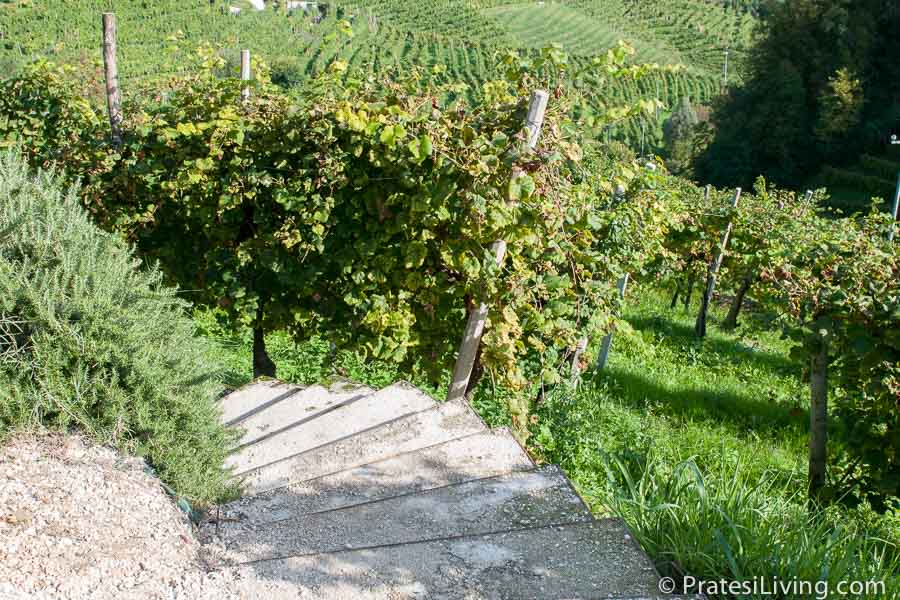
Steps to navigate the steep terraced vineyards
As mentioned above, Conegliano Valdobbiadene Prosecco Superiore DOCG comes from this small region of hill towns located between Conegliano and Valdobbiadene. They produce about 90 million bottles a year. In addition to Prosecco Superiore DOCG and Prosecco DOC, there is also a non-protected designation, which is much of what we have available to purchase in the U.S. The latter, in particular, is a very different wine with more fizz and bubbles and a sweeter taste. That is why it’s so important to understand the difference and distinction between these sparkling wines.
If you learn about the history and landscape of this region, its terroir and terrain, and the proud people that have grown and produced these wines for generations, you will understand why Prosecco Superiore is so special and unique.
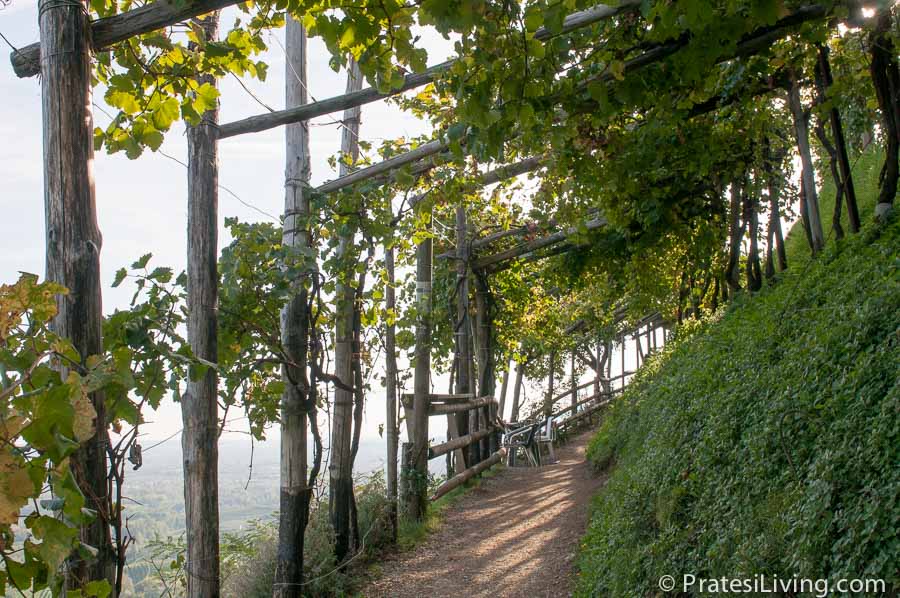
Walking along the hillsides in Valdobbiadene
As I sat overlooking the beautiful vineyards of Valdobbiadene with Roberta and Riccardo, with of course, a glass of Prosecco Superiore in hand, I savored the view and the moment and knew I would never forget either one of them.
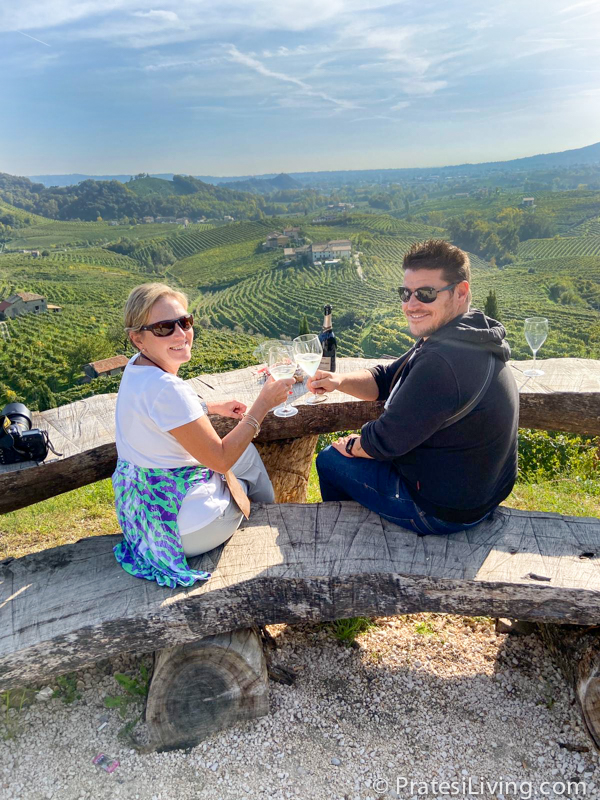
Cin cin to new friends!
Here are suggestions and tips when planning our stay in Conegliano Valdobbiadene Prosecco Superiore DOCG:
Where to stay
If you choose to stay in Conegliano, Hotel Canon d’Oro is a excellent choice. It’s conveniently located within the historic center of the town and is very close to restaurants, shopping, the castle and other historic sites, such as the cathedral.
There are other small hotels, agriturismos, and B&Bs throughout the region. Two other options to consider are Villa Abbazia, a Relais & Chateaux property in Follina, or Cà del Poggio Restaurant and Resort in San Pietro di Feletto.
Hire a Private Guide
Plan to hire a private guide to tour the region and visit the wineries along the Prosecco Road. There are many unique things to see off the beaten path that you will miss on your own or with larger tour groups.
You may also encounter smaller wineries and restaurants, etc. where very little English is spoken, so it’s best to have a guide with you to translate.
I highly recommend Roberta at Prosecco Wine Tour for an authentic local experience. She has a degree in enology and is very knowledgeable about wine. She can also assist in shipping back whatever wines you purchase during your time in Conegliano and Valdobbiadene.
Other Things to do
When you aren’t tasting and sipping Prosecco Superiore, here are some other things to see and do by town:
Refrontolo – Visit the 17th-century little Croda Mill.
Follina – See the Abbey of Santa Maria, dating back to the 11th- and 12th-centuries.
Vittorio Veneto – Explore Serravalle, which is known as the Little Florence of the Veneto.
Col San Martino – Visit the Oratory of S. Virgilio with its frescoes dating back to the 15th-century.
San Pietro di Felletto – One highlight of the town is the Romanesque-style church dating back to the the 12th-century with its beautiful 15th-century frescoes. After exploring the church, schedule a tour of the latteria (dairy) and have a sparkling wine and cheese tasting at Latteria Perenzin. This 4th generation cheesemaker, Emanuela Perenzin, produces lovely award-winning cheeses and her daughter is a sommelier, so she can select your perfect wine pairings. Be sure to leave extra room in your suitcase to bring home local and specialty Italian food products from their cheesebar and gourmet foods shop.
Cison Divalmarion – This town has a beautifully restored castle that dates back to the 14th-century.
Conegliano – The town’s cathedral houses a painting by one of the most influential artists of the Renaissance, Giovanni Battista Cima (also known as Cima de Conegliano). It is suggested (by the records) that he was born in Conegliano around 1459. He then lived and worked in Venice until his death.
Tarzo – Take a cooking class at Our Rustica. This experience also includes Prosecco Superiore. 🙂 I promise you will have a delightful day filled with delicious food, lots of laughter, wonderful company, and plenty of bubbles. You can also stay at their B&B.
Ponte Della Priula – Stop at Pasticceria Ducale on your way back to Venice for a delicious (and beautiful) pastry and cappuccino at this lovely bakery.
* These images and graphs are courtesy of the Consorzio Conegliano Valdobbiadene Prosecco Superiore. A few of them also appear in the video.
If your travel plans bring you to this part of Northeast Italy, you should consider an extended trip and include a visit to Venice and Friuli. If so, these articles may also be of interest:
Travel to Lidia’s Italy, Friuli-Venezia Giulia and a recipe for Herb and Wild Greens Fritatta
Exploring the wines of Friuli-Venezia Giulia, the Northeastern wine region of Italy

This content is protected under International Copyright Laws. Pratesi Living provides this content to its readers for their personal use. No part (text or images) may be copied or reproduced, in whole or in part, without the express written permission of PratesiLiving.com. All rights reserved.
Disclosure – I was a guest of the Consorzio Conegliano Valdobbiadene Prosecco Superiore, but was not compensated by the Consorzio to visit or paid by them for any articles. The opinions expressed regarding my experience are my own.
